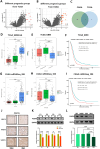Periostin-mediated activation of NF-κB signaling promotes tumor progression and chemoresistance in glioblastoma
- PMID: 40263417
- PMCID: PMC12015317
- DOI: 10.1038/s41598-025-92969-8
Periostin-mediated activation of NF-κB signaling promotes tumor progression and chemoresistance in glioblastoma
Abstract
Glioblastoma (GBM) is the most aggressive form of diffuse glioma, characterized by high lethality. Temozolomide (TMZ)-based chemotherapy is a standard treatment for GBM, but development of chemoresistance poses a significant therapeutic challenge. Despite advances in understanding GBM biology, the mechanisms driving TMZ resistance remain unclear. Identifying vital molecular players involved in this resistance is crucial for developing new therapies. Our results indicated that periostin (POSTN) was significantly upregulated in GBM cell lines and patient samples, correlating with poorer clinical outcomes. POSTN overexpression enhanced GBM cell proliferation, migration, invasion, and chemoresistance, while lentiviral suppression of POSTN significantly reduced these behaviors. In vivo, bioluminescence imaging further confirmed the enhanced tumor growth associated with POSTN overexpression. Bioinformatics analysis was performed to explore the underlying molecular mechanism. The results revealed a strong correlation between POSTN and epithelial-mesenchymal transition (EMT) process and the tumor necrosis factor α (TNFα)-NF-κB signaling pathway. Moreover, exogenous POSTN silencing reduced IκB-kinase α (IKKα) phosphorylation, thereby decreasing NF-κB expression by limiting IκBα degradation. Collectively, our study demonstrated that POSTN-induced activation of NF-κB signaling and EMT processes promoted the malignancy and chemoresistance of GBM, suggesting that POSTN may serve as a reliable prognostic biomarker and potential therapeutic target for GBM.
Keywords: EMT-related phenotypes; Glioblastoma; NF-κB signaling; POSTN; TMZ resistance.
© 2025. The Author(s).
Conflict of interest statement
Competing interests: The authors declare no competing interests.
Figures






Similar articles
-
Nuclear factor I A promotes temozolomide resistance in glioblastoma via activation of nuclear factor κB pathway.Life Sci. 2019 Nov 1;236:116917. doi: 10.1016/j.lfs.2019.116917. Epub 2019 Oct 12. Life Sci. 2019. PMID: 31614149
-
IKBKE enhances TMZ-chemoresistance through upregulation of MGMT expression in glioblastoma.Clin Transl Oncol. 2020 Aug;22(8):1252-1262. doi: 10.1007/s12094-019-02251-3. Epub 2019 Dec 21. Clin Transl Oncol. 2020. PMID: 31865606
-
Triggering of endoplasmic reticulum stress via ATF4-SPHK1 signaling promotes glioblastoma invasion and chemoresistance.Cell Death Dis. 2024 Aug 1;15(8):552. doi: 10.1038/s41419-024-06936-8. Cell Death Dis. 2024. PMID: 39090107 Free PMC article.
-
Importance of Autophagy Regulation in Glioblastoma with Temozolomide Resistance.Cells. 2024 Aug 11;13(16):1332. doi: 10.3390/cells13161332. Cells. 2024. PMID: 39195222 Free PMC article. Review.
-
Harnessing the role of aberrant cell signaling pathways in glioblastoma multiforme: a prospect towards the targeted therapy.Mol Biol Rep. 2024 Oct 19;51(1):1069. doi: 10.1007/s11033-024-09996-3. Mol Biol Rep. 2024. PMID: 39424705 Review.
References
-
- Ma, R., Taphoorn, M. J. B. & Plaha, P. Advances in the management of glioblastoma. J. Neurol. Neurosurg. Psychiatry. 92, 1103–1111. 10.1136/jnnp-2020-325334 (2021). - PubMed
-
- Shaw, R., Basu, M., Karmakar, S. & Ghosh, M. K. MGMT in TMZ-based glioma therapy: multifaceted insights and clinical trial perspectives. Biochim. Biophys. Acta Mol. Cell. Res.1871, 119673. 10.1016/j.bbamcr.2024.119673 (2024). - PubMed
MeSH terms
Substances
Grants and funding
LinkOut - more resources
Full Text Sources
Medical
Miscellaneous

